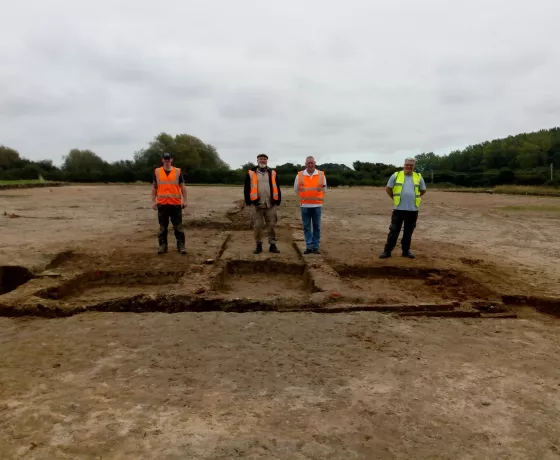The team on site have been beavering away cleaning up walls and trying to connect which bits of wall goes with what. Nick, our Project Officer running the site, picks where he wants our archaeologists to dig each slot (see the week 11 update for an explanation about the word ‘slot’). The aim is to gain the most information possible from each hole we dig, so picking the best locations for these can be a tough job. At the moment, most of the slots we’re digging are answering the question we want answered, but they’re also throwing up a several additional questions. This is because there’s a load of archaeology beneath what we can see on the surface. This is what we call ‘stratigraphy’. Stratigraphy is the study of layers (or strata) which have been deposited over time. The basic idea behind stratigraphy is that lower layers are older than upper layers – so think of it like layers of a cake! Stratified deposits can include soils, sediments and rocks, as well as man-made features such as pits, postholes and ditches. So, this essentially means that if we dig a slot across a wall which we can see on the surface of the ground and then find a pit underneath, this means that the pit is older than the wall.

If you saw our week 10 update, you’ll remember that we had happened upon a large Iron Age circular ditch. We initially thought that the ring was complete, but now that we’ve done a bit more digging, we can see that there is actually an entrance on its eastern side. The team have spent several days doing some back breaking cleaning of the interior space to see if there are any contemporary features inside to give us a hint as to what the circular ditch was used for, but unfortunately, we couldn’t find anything. We do however, have quite a lot of rather nice pottery from the ditch itself.
The fact that we’ve found this pile of pottery tells us that it was probably thrown into the ditch on purpose, as there’s too much of it to have gotten in there by accident. Another thing we think about when we find pottery is we check to see how ‘abraded’ it is. This essentially means we look at the size of a piece of pottery and at the broken edges to see how worn they are. A large piece of pottery usually means that it has not moved far from its place of deposition. It’s the same for pottery with unabraded edges, if the broken edges are quite sharp and angular, it means it hasn’t moved much after being put in the ground. Small pieces of pottery with rounded edges would be described as highly abraded. This means that they may have ended up in the place we discovered them by accident and have spent many years being moved around in the ground – like when you go for a walk across a field you might see some small pieces of pottery or brick in the soil.
Elsewhere, we’ve been getting to grips with the drainage system put in place for the Napoleonic camp. We’ve established that there are quite a lot of French drains all across the site – these are trenches dug into the ground and then backfilled with tile. French drains are still used today; however, modern examples have a plastic pipe at the base of the trench and are backfilled with stones or gravel. The main thing we have discovered about the Napoleonic drains is that they are still functioning! Every single one we’ve dug so far still have water running through them, which is quite amazing if you think about how old they are. The team on site are less excited about this because it means that they are having to try and dig a slot through something which is constantly filling with water! Not an envious job at this time of year considering how cold it is outside.
You’ll see from the above photograph that these drains contain an awful lot of brick and tile. Our poor Supervisor Jack, who dug this, thought he was going to be digging a straightforward slot through a ditch, but it turned into a behemoth of a slot (the red and white scale is 2m long). Just look at that massive pile of tile he took out of it!!
Other posts in this collection
Read our latest posts about the archaeological investigations at Weeley.





